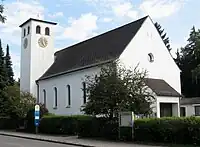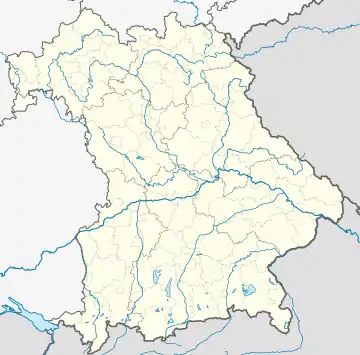| Maria Rosenkranzkönigin Mary, Our Lady of the Rosary | |
|---|---|
 Maria Rosenkranzkönigin | |
 Neubiberg, Bavaria  Maria Rosenkranzkönigin (Germany) | |
| General information | |
| Status | In use |
| Type | Church |
| Architectural style | Modern |
| Address | Haupstraße |
| Town or city | Neubiberg |
| Country | Germany |
| Coordinates | 48°04′30″N 11°40′03″E / 48.0751°N 11.6675°E |
| Elevation | 417 metres (1,368 ft) |
| Inaugurated | 11 November 1928 |
| Owner | Roman Catholic Church |
| Height | |
| Architectural | 21.5 metres (71 ft) |
| Dimensions | |
| Circumference | 106.6 metres (350 ft) |
| Technical details | |
| Material | Rendered |
| Floor area | Internal: 246.4 square metres (2,652 sq ft) External: 532 square metres (5,726 sq ft) |
| Design and construction | |
| Architect(s) | Franz Xaver Boemmel |
| Main contractor | Metzger & Spörkl |
| Website | |
| Maria Rosenkranzkönigin | |
Maria Rosenkranzkönigin (English: "Our Lady of the Rosary" is a Roman Catholic parish church in the municipality of Neubiberg, near (Munich) in Bavaria. The church was built in 1928 using functional-modern forms of architecture. It was consecrated on November 11, 1928 by Michael Cardinal von Faulhaber.[1]
History
In 1911, urban development began in the woodland along the Munich-Kreuzstraße railway line. The growth of the new settlements was encouraged through advertising slogans such as Return to nature, in the forest you will find peace!. Neubiberg was promoted as the future garden city. As early as 1913, the first settlers erected a statue of the Blessed Virgin Mary, transferring it in 1921 to a newly‑consecrated chapel of Maria im Walde (The Chapel of St Mary of the Woods.) Today, it stands as a memorial church for the victims of the two World Wars.[2]
As the settlement continued to expand, the chapel became too small for its congregation. In 1920, Munich architect Franz Xaver Boemmel founded Kirchenbauverein Gartenstadt-Neubiberg e.V. (The Association for Supporting the Construction of a Church in Gartenstadt-Neubiberg) with the aim of funding a new church in the town. The building was erected by local company Metzger & Spörkl. The church was consecrated by Michael, Cardinal von Faulhaber on November 11, 1928.[2]
In 1968, the church was renovated and extended with a nave aisle.[3] In 2004, electric heating for the church benches was installed and, in 2005, the walls of the church were stripped of their old colour and whitewashed, according to the requirements of the regional authorities for historic preservation.[4]
Architecture
The church is a plain building with a clear structure and whitewashed walls. Its total length is 40 metres (131 ft) (internal: 22 metres or 72 feet) and its width is 13.3 metres (44 ft) (internal: 11.2 metres or 37 feet). A tower with a flat, tiled roof adjoins the nave at the north east. It is 21.5 metres (71 ft) high and houses three steel bells.[3]
The church is registered for preservation on the regional authority's list of heritage buildings, record number D-1-84-146-1.[5]
Parish
The Parish of Rosenkranzkönigin, Neubiberg, belongs to the Roman Catholic Deanery of Munich-Perlach. The Parish boundaries are approximately the same as those of the municipality of Neubiberg, although the village of Unterbiberg, with its filial church of St. Georg, belongs to the parish St. Michael in Munich-Perlach.[6]
See also
Links
Bibliography
References
- ↑ muenchen-stadtteile.de: Verschiedene schöne Kirchen in Bayern Archived 2011-11-15 at archive.today
- 1 2 "The Parish of the Rosary". rosenkranzkoenigin.de. Retrieved 4 December 2016.
- 1 2 Pfarrei Rosenkranzkönigin: Geschichte.
- ↑ "Katholische Pfarrgemeinde Rosenkranzkönigin Neubiberg: Pfarrbrief Herbst 2005" (PDF). rosenkranzkoenigin.de. p. S. 6–7. Retrieved 4 December 2016.
- ↑ Bayerisches Landesamt für Denkmalpflege Archived 2016-08-10 at the Wayback Machine
- ↑ Rosenkranzkönigin Neubiberg: Pfarrsprengel
